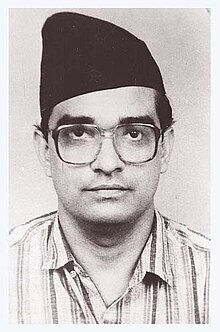Madan Bhandari
Madan Kumar Bhandari | |
|---|---|
मदनकुमार भण्डारी | |
 | |
| Born | June 27, 1952 |
| Died | May 16, 1993 (aged 40) Dasdhunga, Chitwan, Nepal |
| Cause of death | Possibly murdered (car accident) |
| Body discovered | Three days later |
| Resting place | Arya Ghat, Pashupati |
| Monuments | Madan Bhandari Memorial College, Madan-Ashrit Highway, Madan Bhandari Road |
| Nationality | Nepalese |
| Other names | जनताका नेता (People's leader) |
| Citizenship | Nepali |
| Known for | जनताको बहुदलीय जनवाद "People's Multiparty Democracy" |
| Notable work | Refrendum |
| Political party | Communist Party of Nepal (Unified Marxist-Leninist) |
| Movement | People's Movement I (1990) |
| Opponent | Panchayat system |
| Spouse | Bidhya Devi Bhandari |
| Children | 2 |
Madan Kumar Bhandari (Template:Lang-ne) (June 27, 1952[1] – 16 May 1993[2]) was a Nepalese politician and communist leader. He was sensational youth Communist leader who rose to prominence after being party leader and defeating great rival leader Krishna Prasad Bhattarai in general election. As a communist leader, his fact based speech with use of proper vocabulary were awestrucking with combination of great courage and determination to speak such that no one shall match that audacity, not even the beloved Nepalese King. He was the mouth of suppressed Nepalese who were thrusted by Nepalese feudal system.The popular English newspaper 'The Newyork Times' featured him writing 'Karl Marx lives in Nepal.'
Life
Bhandari was born in Dhungesangu village of Taplejung district of eastern Nepal. He studied in Medibung School in Taplejung and in Varanasi, India. In 1972, he became the central committee member of the Janabadi Sanskritik Morcha (Democratic Cultural Front), a student movement launched by Pushpa Lal Shrestha. Around 1976, he left Pushpa Lal's Communist Party of Nepal to launch the Mukti Morcha Samuha ("Liberation Front Group"), which formed an alliance with the survivors of the Jhapa Movement in 1978. He was a founder member of the Communist Party of Nepal (Marxist-Leninist) preceding the 1980 referendum and was elected general secretary at its fourth national in 1986.
When CPN (ML) merged into the Communist Party of Nepal (Unified Marxist-Leninist) in 1991, Bhandari became the general secretary. He was the engineer behind the program of CPN (UML) "People's Multiparty Democracy"), which led his party as the strongest communist party of Nepal for several years even after his death.
1991 Elections and aftermath
The UML party, under the leadership of Bhandari, swept all but one seat in the Himalayan capital in 1991 elections, and returns in the nation's first free elections in more than three decades underscored the emerging power of the world's only growing Communist movement.[3] "It is a vote for democracy. It is a vote for independence. It is a vote for the alleviation of poverty," said Bhandari afterwards.[3]
Bhandari is credited with bringing the concept of Democratic Communism to the fore. "People's Multiparty Democracy", to be precise; leading the Nepalese communist revolution into a new and peaceful direction, and giving world communism a new path. He firmly believed that the way for communists to gain power was through popular vote and not radical armed movements. However, shortly after the elections, he died mysteriously in a car accident in Dasdhunga, Chitwan.[4]
Death
On 16 May 1993, Bhandari died, supposedly in a car accident without any eyewitness. Many believe he was murdered. Among the three passengers inside the car, only the driver Amar Lama survived; the two leaders Madan Bhandari and Jeev Raj Ashrit died.
His body was recovered three days later and kept in Dasharath Rangashala where streams of people kept on visiting the place all day and night with tears in their eyes.[4] It was a funeral procession of huge magnitude with unending waves of people from all walks of life surging from all sides to have a last glimpse of their leaders.[4]
Possible conspiracy again came into concern after the only survivor of that crash, driver Amar Lama, was murdered after about 10 years in Kirtipur.[5] A group of unidentified gunmen, who abducted Lama from the office of Tajakhabar Weekly tabloid at around 1:45 in the afternoon, took him in a taxi to the hamlet of Kirtipur on the southwestern outskirts of the capital and shot him dead. The assassins then fled towards Panga village.[5]
References
| Part of a series on |
| Communism in Nepal |
|---|
 |
|
|
- ^ K.C., Surendra. Aitihasik dastavej sangroh - bhag 2. Kathmandu: Pairavi Prakashan, 2063 B.S.. p 464.
- ^ 1
- ^ a b FINEMAN, MARK (1991-05-15). "Communists Celebrate Nepal Victories : Elections: Katmandu goes Marxist but moderates lead in countryside voting". Los Angeles Times. ISSN 0458-3035. Retrieved 2015-10-28.
- ^ a b c "A Death Heavier than the Himalayas". www.marxists.org. Retrieved 2015-10-28.
- ^ a b Acharya, Yuvraj (July 28, 2003). "Driver of murdered UML leaders killed".
